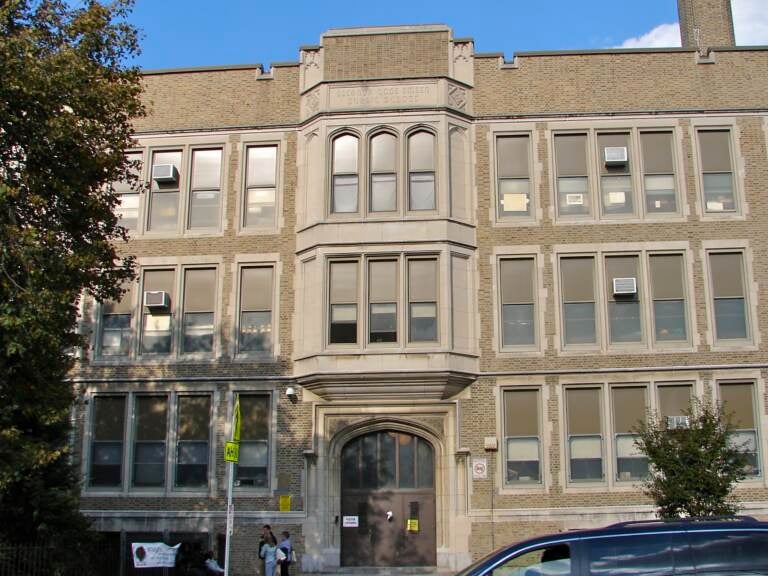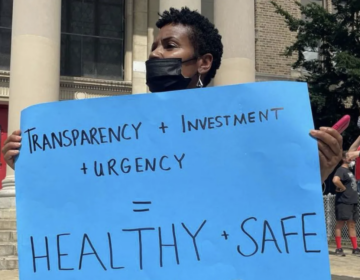As climate change makes Philly temps rise, so does urgency to make schools cooler
The start and end of Philly’s school years have gotten hotter. But as another school year ends, more than half of district schools still lack air conditioning.

Emlen Elementary School in East Mount Airy. (Wikimedia Commons)
When John Coats goes to work at Emlen Elementary School in East Mount Airy, the best way to teach addition and subtraction is not the only thing on his mind. He also has to worry about keeping his students cool.
Emlen is one of more than 100 schools in the School District of Philadelphia — or about 60% — that lack central air conditioning. Coats estimates just about a third of the classrooms at Emlen have functional window units, but his second-floor classroom is not one of them.
“It’s an old building built in 1925, so it maintains the heat,” he said. “When the sun hits it, it’s hotter in the building than it is outside.”
The building’s walls start to sweat, and floors become dangerously slippery, said Coats, who teaches math and is the school climate facilitator at Emlen. Teachers bring in fans and freeze pops. Coats is often forced to take his class outside and pivot to a different lesson, because he notices his sweltering 5 to 12-year-old students losing focus.
“They’re distracted,” he said. “You’re going to lose more than half your class.”
With aging facilities, the School District of Philadelphia is struggling to keep students cool and ready to learn in a warming world. Philadelphia public schools let out for the summer Tuesday, after a spring that brought historically hot temperatures to the city and ahead of a summer that’s expected to be an above-average scorcher. Late last month, schools sent students home early due to excessive heat — reminiscent of the rocky start to the school year in 2018, when the heat made students and teachers ill, and schools closed early multiple days.
Researchers have found a link between hotter temperatures and lower test scores, and that heat contributes to educational inequality. Across much of the country, schools are struggling to operate in increasingly hot weather.
Coats, a teacher of 36 years in the district and nine at Emlen Elementary School, said the issue of extreme heat in classrooms seems to be getting worse.
“It’s always been a problem, the climate of the building,” he said. But “it gets extremely hot now more than it used to.”
Temperature records back him up.
The start and end of the school year in Philadelphia have gotten hotter in recent decades, according to data analyzed for PlanPhilly by the nonprofit research and news organization Climate Central.
Philly’s average daily high temperature from mid-May to mid-June and from mid-August to mid-September has gone up around 1 to 2 degrees Fahrenheit since 1970.
While this change may sound small, it still makes a difference in how people feel, said Jen Brady, a senior data analyst at Climate Central.
“What you’re seeing is a shifting of the extremes,” Brady said. “When you’re looking at on average, temperatures are going up, it probably means that you’re having some more extreme hot days as well.”
In fact, Brady’s analysis shows that dangerously hot days have become more common at the beginning of the school year in Philly.
During the last three decades of the 20th century, Philadelphia only saw an average of one day that reached at least 95 degrees in the first half of September every seven to eight years, according to Climate Central. But in the last 20 years, the city got that hot once every five years — and in the last decade, once every three.
Places like Philadelphia contend with the urban heat island effect, where buildings and roads hold warmth. Brady said that increasing temperatures are very clearly linked with climate change, and warming is only expected to continue.
“It’s only going to get higher in the future,” Brady said. “There’s no reason to expect this to slow down.”
Some worry that the School District of Philadelphia is not prepared.
“Our buildings aren’t equipped to manage the climate situations that we’ve got right now,” said Councilmember Helen Gym, a former teacher and frequent critic of the district’s facilities.
The district’s aging building stock has repeatedly failed students, with leaking roofs and dangerous asbestos conditions. A 2017 report revealed the district had $4.5 billion in deferred maintenance.
The district has made some progress on air conditioning. Currently, 40% of school buildings, up from just 27% in 2018, have central air conditioning, according to district officials. In schools without central air, some — but not all — classrooms have window or room units. Air conditioning projects are underway in over 40 schools, according to district officials, including several central air and window unit installations scheduled for this summer.
The district plans to spend $325 million of its latest round of COVID relief money on facility upgrades, including HVAC projects. Back in 2018, the district estimated that upgrading all its school buildings to have air conditioning would have cost $144 million. The district is currently in the midst of a facilities planning project expected to result in recommendations next year that will ultimately inform a facilities master plan to prioritize spending.
“We have been working with urgency over the past five years to install updated air conditioning systems and the extensive electrical systems that support them in our schools,” Chief Operating Officer Reggie McNeil wrote in a statement posted to the district’s website early this month. “Given the average age of our schools, the extensive scope of work needed and the available capacity and resources, each project could take as much as two years to complete.”
But leaders of the teachers’ union say Philly students aren’t seeing results fast enough. Philadelphia Federation of Teachers President Jerry Jordan admitted the district has upgraded electrical systems in some schools, but “not in the vast majority” of buildings.
“We’ve had cases where even [union] members have purchased air conditioners,” he said. “They’ve brought them into the school for installation in their classrooms, and because of the poor wiring, the air conditioners would cause the electricity in the building to go out in certain places.”
For now, the district will monitor interior building temperatures when outside temperatures are forecast to reach at least 85 degrees or a heat index of at least 90 degrees, McNeil announced. If temperatures in instructional spaces are expected to hit 90 degrees, the district will consider shifting students to virtual learning.
“Our goal going forward is to make that decision only for the schools that do not have sufficient air conditioning systems to keep temperatures below 90 degrees Fahrenheit, and to make the decision as early as possible, preferably the day before, to minimize last-minute disruption for our students, families and staff,” McNeil wrote.
Gym, who said she pressed the district on the air conditioning issue in recent years, sees it as a matter of equity, with Philly students shortchanged compared to students in wealthier districts with more air conditioning. She sees remote learning during hot days as a “temporary, emergency, last-resort” measure, where students without internet access or air conditioning at home will continue to struggle.
“There’s no question that the condition of our city buildings should not dictate our children’s education,” she said. “But what we know is that’s happening time and time again.”
A 2017 site assessment report for Emlen elementary school, where John Coats teaches, recommended replacing the electrical distribution system, which the report said was “beyond service life,” to support central air conditioning equipment. The report estimated this would cost $653,254.
Five years later, the district plans to start designing Emlen’s electrical upgrades in December, said spokesperson Christina Clarke.
Coats is anxious to see the upgrades done. He worries especially about his students in special education programs, students with allergies or asthma, and students who come to school tired after struggling to sleep in homes without air conditioning.
“[District officials] keep putting a Band-Aid on an issue and say they’ll get to it later,” Coats said. “Well, that’s why we are where we are today.”
 WHYY is one of over 20 news organizations producing Broke in Philly, a collaborative reporting project on solutions to poverty and the city’s push towards economic justice. Follow us at @BrokeInPhilly.
WHYY is one of over 20 news organizations producing Broke in Philly, a collaborative reporting project on solutions to poverty and the city’s push towards economic justice. Follow us at @BrokeInPhilly. WHYY is your source for fact-based, in-depth journalism and information. As a nonprofit organization, we rely on financial support from readers like you. Please give today.









